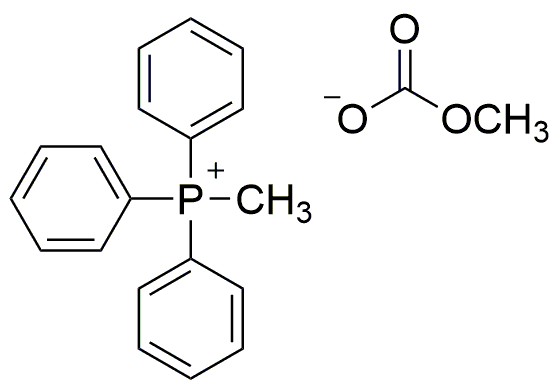Methyltriphenylphosphonium methylcarbonate is widely utilized in research focused on:
- Organic Synthesis: This compound serves as a versatile reagent in organic chemistry, particularly in the synthesis of various organic compounds, including phosphonium salts, which are key intermediates in many chemical reactions.
- Pharmaceutical Development: It is used in the pharmaceutical industry for the development of new drugs, especially in the creation of phosphonium-based compounds that can exhibit unique biological activities.
- Material Science: The compound finds applications in the development of advanced materials, such as polymers and coatings, due to its ability to modify physical properties and enhance performance.
- Catalysis: Methyltriphenylphosphonium methylcarbonate acts as a catalyst in various chemical reactions, improving reaction rates and yields, which is particularly beneficial in industrial processes.
- Research in Green Chemistry: It is explored in green chemistry applications, where its use can lead to more sustainable and environmentally friendly chemical processes, reducing waste and energy consumption.
General Information
Properties
Safety and Regulations
Applications
Methyltriphenylphosphonium methylcarbonate is widely utilized in research focused on:
- Organic Synthesis: This compound serves as a versatile reagent in organic chemistry, particularly in the synthesis of various organic compounds, including phosphonium salts, which are key intermediates in many chemical reactions.
- Pharmaceutical Development: It is used in the pharmaceutical industry for the development of new drugs, especially in the creation of phosphonium-based compounds that can exhibit unique biological activities.
- Material Science: The compound finds applications in the development of advanced materials, such as polymers and coatings, due to its ability to modify physical properties and enhance performance.
- Catalysis: Methyltriphenylphosphonium methylcarbonate acts as a catalyst in various chemical reactions, improving reaction rates and yields, which is particularly beneficial in industrial processes.
- Research in Green Chemistry: It is explored in green chemistry applications, where its use can lead to more sustainable and environmentally friendly chemical processes, reducing waste and energy consumption.
Documents
Safety Data Sheets (SDS)
The SDS provides comprehensive safety information on handling, storage, and disposal of the product.
Product Specification (PS)
The PS provides a comprehensive breakdown of the product’s properties, including chemical composition, physical state, purity, and storage requirements. It also details acceptable quality ranges and the product's intended applications.
Certificates of Analysis (COA)
Search for Certificates of Analysis (COA) by entering the products Lot Number. Lot and Batch Numbers can be found on a product’s label following the words ‘Lot’ or ‘Batch’.
*Catalog Number
*Lot Number
Certificates Of Origin (COO)
This COO confirms the country where the product was manufactured, and also details the materials and components used in it and whether it is derived from natural, synthetic, or other specific sources. This certificate may be required for customs, trade, and regulatory compliance.
*Catalog Number
*Lot Number
Safety Data Sheets (SDS)
The SDS provides comprehensive safety information on handling, storage, and disposal of the product.
DownloadProduct Specification (PS)
The PS provides a comprehensive breakdown of the product’s properties, including chemical composition, physical state, purity, and storage requirements. It also details acceptable quality ranges and the product's intended applications.
DownloadCertificates of Analysis (COA)
Search for Certificates of Analysis (COA) by entering the products Lot Number. Lot and Batch Numbers can be found on a product’s label following the words ‘Lot’ or ‘Batch’.
*Catalog Number
*Lot Number
Certificates Of Origin (COO)
This COO confirms the country where the product was manufactured, and also details the materials and components used in it and whether it is derived from natural, synthetic, or other specific sources. This certificate may be required for customs, trade, and regulatory compliance.


